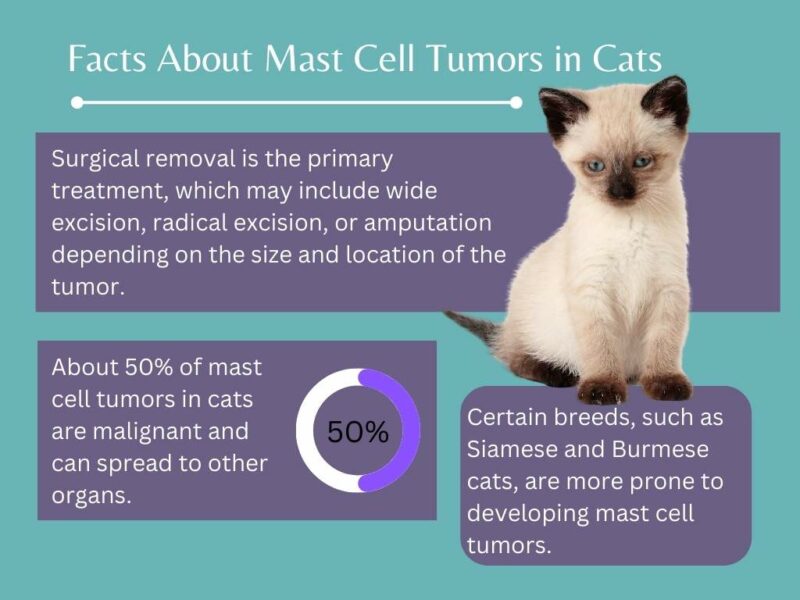What is Mast Cell Tumor in Cats?
What is it?
How is it Treated?
Breed Predispositions
No specific breeds of cats are known to be predisposed to mast cell tumors. However, it is more common in middle-aged to older cats.
Introduction
Samantha was a proud cat owner who loved her fur baby, Fluffy, more than anything. She made sure to provide Fluffy with the best care possible, ensuring regular check-ups and a healthy diet. One day, while brushing Fluffy, Samantha noticed a small, unusual lump on her side. Alarmed, she immediately scheduled an appointment with the veterinarian. After conducting several tests, the vet delivered the unsettling news: Fluffy had a mast cell tumor. Facing this diagnosis, Samantha felt overwhelmed and unsure of what to expect.
Mast cell tumor in cats is a cancer that arise from mast cells, a specific type of immune cell scattered throughout various tissues in the body. The development of these tumors occurs due to certain processes within the body that trigger the uncontrolled growth and accumulation of these abnormal mast cells. Mast cell tumors can manifest in different areas, such as the skin (resulting in cutaneous tumors), the gastrointestinal tract leading to intestinal MCTs, the spleen causing splenic MCTs, or other organs leading to visceral MCTs.
Their severity can span from benign to malignant, with some forming high-grade tumors. Mast cell tumors might exhibit characteristics similar to other types of cancers, such as squamous cell carcinoma. Knowledge about mast cell tumors’ occurrence aids in the timely recognition of the condition and prompt pursuit of proper veterinary care. Managing mast cell tumors involves addressing abnormal cell growth and delivering supportive care to preserve the cat’s overall well-being.
What is a Feline Mast Cell?
A feline mast cell refers to a type of cell found in the tissues of cats, specifically the mast cells. Mast cells are a vital immune system component and play a role in the body’s response to inflammation and allergic reactions. These cells contain granules filled with various substances, including histamine, released when the mast cell is activated.
In cats, mast cells are found in various tissues throughout the body, including the skin, respiratory tract, gastrointestinal tract, and other organs. They are particularly abundant in the skin. Mast cells have receptors on their surface that can recognize specific molecules, triggering their activation and release of the stored substances. This release can contribute to local inflammation and immune responses.
Feline mast cells are similar to those in other animals and humans but may have some species-specific characteristics. Understanding the behavior and function of feline mast cells is important in diagnosing and treating conditions related to mast cell activity, such as mast cell tumors or allergic reactions in cats.

What are the Types of Mast Cell Tumors in Cats?
In felines, mast cell tumors (MCTs) can be classified into different types based on their characteristics. The types of mast cell tumors in cats include:
Cutaneous Mast Cell Tumors
The most common mast cell tumor found in cats is cutaneous mastocytoma. It is the second leading cause of feline cutaneous neoplasms. Cutaneous MCT tumors predominantly affect the skin and are typically seen as lumps or nodules on or beneath the skin surface. They can appear variable, ranging from small, raised bumps to larger, ulcerated masses. Cutaneous mast cell tumors in cats can exhibit different grades of malignancy, ranging from low-grade, slow-growing tumors to high-grade, rapidly progressing malignancies.
Subcutaneous Mast Cell Tumors
These tumors develop in the subcutaneous tissue beneath the skin. They are often characterized by soft, movable masses that can be felt during physical examination. Subcutaneous mast cell tumors in cats may also vary in malignancy, and proper diagnosis is crucial to determine the appropriate treatment approach.
Gastrointestinal Mast Cell Tumors
These tumors arise in the gastrointestinal tract, commonly in the stomach or intestines. They can cause various symptoms, such as vomiting, diarrhea, weight loss, or abdominal pain. Gastrointestinal mast cell tumors in cats can be challenging to diagnose as they may mimic other gastrointestinal conditions, and surgical intervention is often required for definitive diagnosis and treatment.
Splenic Mast Cell Tumors
These tumors develop in the spleen, an organ involved in blood filtration and immune function. Splenic mast cell tumors in cats can be difficult to diagnose as they may not cause specific clinical signs until they become large or rupture. Surgery is often necessary to remove the affected spleen, and further treatment may be required depending on the stage and behavior of the tumor.
It’s important to note that each type of mast cell tumor can have a different prognosis and require tailored treatment approaches. A comprehensive evaluation by a veterinarian, including diagnostic tests and staging, is essential to determine the most appropriate management plan for cats with mast cell tumors.

Causes of Mast Cell Tumor in Cats
The precise reasons behind the development of mast cell tumors (MCTs) in cats remain elusive. Several factors, however, are postulated to be contributory to their occurrence. Some of these potential contributors encompass:
- Genetic Factors: Specific breeds like Siamese cats and domestic shorthair felines seem to have an increased incidence of mast cell tumors, implying a probable genetic predisposition to this type of tumor.
- Environmental Triggers: It’s theorized that contact with certain environmental elements or substances, such as chemicals, radiation, or carcinogens, could raise the risk of developing MCTs in cats. Despite this, definitive identification of specific causative agents remains pending.
- Immune System Irregularities: The emergence of mast cell tumors might be tied to irregularities or malfunction in the immune system. Changes in immune response mechanisms or immune surveillance could facilitate the unchecked proliferation of mast cells.
- Inflammatory Conditions: Chronic inflammation, whether localized or systemic, is linked to a heightened risk of MCT development in cats. Inflammatory processes can stimulate the growth and multiplication of mast cells.
While these factors are theoretically connected to MCTs, the exact causative mechanism of this second most common skin tumor in cats still requires comprehensive understanding. Continued research is imperative to acquire a more thorough knowledge of the underlying causes and risk factors associated with mast cell tumors, which can appear as a single skin tumor or multiple mast cell tumors, involve the lymph nodes, or even affect the internal organs, particularly in older cats.
Symptoms of Mast Cell Tumor in Felines
Here are some typical signs correlated with mast cell tumors (MCTs), which are particularly common in cats’ skin:
- Skin Manifestations: Various formations such as lumps, nodules, or masses appearing on or underneath the skin. These can fluctuate in size, texture, and physical appearance.
- Inflammation or Amplification: Localized swelling or enlargement of the affected area, especially noticeable in cutaneous MCTs.
- Itching or Scratching: Cats might frequently lick, scratch, or bite at the tumor site due to discomfort or irritation. This itching is because the tumors produce substances that lead to allergy-like symptoms.
- Ulceration: Open sores or wounds that may surface on skin tumors, especially in high-grade or aggressive MCTs.
- Gastrointestinal Indicators: Symptoms like vomiting, diarrhea, decreased appetite, weight loss, or abdominal discomfort, specifically in cats that develop a mast cell tumor in the gastrointestinal tract.
- Systemic Symptoms: Generalized signs such as lethargy, weakness, diminished activity level, or loss of appetite may present in more advanced or widespread cases, even when multiple tumors are involved.
These symptoms we associate with allergic responses and other conditions do not solely indicate MCTs. A thorough diagnosis by a veterinarian, including physical examination and diagnostic tests, is pivotal to ascertaining the origin of these symptoms and confirming the existence of a mast cell tumor.
Diagnosis of Feline Mast Cell Cancer
Veterinary professionals at an animal hospital leverage several techniques to accurately diagnose mast cell tumors (MCTs) in cats, which typically originate from a specific type of white blood cell. These diagnostic methods may encompass:
Physical Assessment
This entails the veterinarian meticulously inspecting the cat’s body during a physical examination, paying particular attention to any visible skin masses, lumps, or lesions. They may gauge the tumors’ size, shape, texture, and location. Additionally, they palpate the regional lymph nodes to inspect for any enlargement, potentially indicating tumor spread.

Fine Needle Aspiration (FNA)
FNA consists of inserting a small-gauge needle into the tumor to extract a sample of cells and fluid. The acquired material is then spread onto slides, stained, and analyzed under a microscope. A veterinary pathologist evaluates the specimen for the presence of mast cells and scrutinizes their characteristics, such as shape, size, and staining patterns.
Biopsy
A biopsy is a surgical procedure that involves extracting a tissue sample from the suspected tumor. The biopsy can be acquired through surgical excision, where the entire tumor is removed, or via an incisional biopsy, which involves obtaining a smaller sample. The tissue sample is dispatched to a veterinary pathologist for histopathological analysis.
Histopathology
This method involves a veterinary pathologist conducting a microscopic examination of the collected tissue sample. They probe the tissue for the presence of mast cells, assess the tumor’s grade (degree of malignancy), and provide additional information about its characteristics, such as mitotic index (rate of cell division) and the presence of invasion into surrounding tissues. Histopathology is indispensable for confirming the diagnosis and determining the appropriate treatment course.
Imaging
In instances where metastasis or deeper structure involvement is suspected, imaging techniques may be utilized. X-rays can help identify the presence of tumors in the chest or abdomen, while ultrasound yields detailed images of internal organs, gauging tumor size, location, and potential spread. More advanced imaging modalities like computed tomography (CT) scans, or magnetic resonance imaging (MRI) may be employed to evaluate the tumor and its surrounding structures comprehensively.
Blood and urine tests can also be performed to check kidney or liver function and detect any issues affecting treatment options or prognosis.
These diagnostic tests are critical in accurately diagnosing, staging, and determining suitable treatment options for mast cell tumors in cats. By utilizing these methods in conjunction with the expertise of veterinary professionals, a tailored approach for managing MCTs and enhancing the cat’s prognosis can be developed.
Treatment for Mast Cell Tumors in Cats
The therapeutic approach to mast cell tumors (MCTs) in cats relies on various factors, including the grade and stage of the tumor, its location, and the cat’s overall health. The veterinarian may propose different treatment options, such as:
Surgery
Surgical excision is the primary treatment for MCTs in cats. The goal is to remove the tumor along with a margin of healthy tissue to minimize the risk of recurrence. In some cases, additional procedures like lymph node removal may be necessary if there is evidence of tumor spread.
Radiation Therapy
Radiation therapy might be suggested for specific situations, particularly when the tumor is extensive, has permeated surrounding tissues, or cannot be entirely excised. It endeavors to annihilate cancer cells and diminish tumor size, offering palliative or curative benefits depending on the circumstances.
Chemotherapy
Chemotherapy could be implemented in cases where there is evidence of tumor spread or in dealing with high-grade or aggressive MCTs. It comprises drugs that aim at and eliminate cancer cells, administered orally or intravenously. Chemotherapy is often combined with surgery or radiation therapy to boost effectiveness.
Supportive Care
Supportive care measures hold significant importance in managing MCTs. This could encompass medications to relieve pain, control allergic reactions provoked by circulating mast cells, manage gastrointestinal symptoms, or address any other needs pertinent to the tumor or its treatment.
The treatment strategy for MCTs in cats is highly personalized, with decisions made considering the cat’s overall health, the specific characteristics of the tumor, and the owner’s preferences. Routine follow-up examinations and monitoring are essential to assess the response to treatment and tackle any potential complications or tumor recurrence.
Consultation with a veterinarian is crucial as they will guide the treatment process and provide apt recommendations based on the unique circumstances of the cat’s MCT.
Prevention for Mast Cell Tumors in Cats
While the exact instigators of feline mast cell tumors (MCTs) remain unclear, there exist various proactive measures pet owners can take to potentially curtail the risk or detect MCTs in the early stages:
- Routine Veterinary Visits: Organize regular check-ups with your veterinarian, enabling them to conduct comprehensive physical examinations and track any health changes in your cat. Regular assessments can assist in the early detection of any irregularities or masses.
- Skin and Tumor Monitoring: Regularly inspect your cat’s skin, focusing on areas where MCTs typically manifest, such as the head, neck, limbs, and abdomen. Be vigilant for new lumps, bumps, or skin lesions, and swiftly report any changes to your veterinarian, especially as many mast cells can indicate the presence of a tumor.
- Environmental Mindfulness: Limit your cat’s exposure to potential environmental factors that might elevate the risk of MCTs. This includes curtailing their interaction with potential carcinogens or harmful substances like certain chemicals or pesticides.
- Prompt Veterinary Intervention: Seek veterinary attention immediately if you observe any worrisome signs or symptoms, such as the emergence of new masses or shifts in your cat’s behavior. A swift diagnosis and treatment can significantly enhance the outcome of MCTs and ensure that cancer has been fully removed.
- Genetic Considerations: If you’re contemplating breeding your cat, liaise with a reputable breeder or veterinarian to endorse responsible breeding practices and diminish the risk of genetic predisposition to MCTs.
While these preventative measures may aid in reducing risk or early identification of MCTs, it’s crucial to remember that not all cases can be prevented. Regular veterinary care and attentiveness are key in monitoring your cat’s health and addressing any concerns promptly. In the case of mast cell tumors located internally, prompt attention becomes even more critical as the treatment can be risky for your cat. Therefore, being mindful of the tumor’s location, the itching because the tumors produce specific substances, and the prognosis (often less than one year after treatment) is essential.
Remember, when released, the mast cell possesses granules that can exacerbate the condition, which underlines the importance of confirming that cancer has been fully removed, particularly since half of all mast cell tumors reoccur in the skin form of the feline condition.
Frequently Asked Questions
Disclaimer: The information provided on this veterinary website is intended for general educational purposes only and should not be considered as a substitute for professional veterinary advice, diagnosis, or treatment. Always consult a licensed veterinarian for any concerns or questions regarding the health and well-being of your pet. This website does not claim to cover every possible situation or provide exhaustive knowledge on the subjects presented. The owners and contributors of this website are not responsible for any harm or loss that may result from the use or misuse of the information provided herein.







